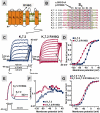Infantile spasms and encephalopathy without preceding neonatal seizures caused by KCNQ2 R198Q, a gain-of-function variant
- PMID: 27861786
- PMCID: PMC5219941
- DOI: 10.1111/epi.13601
Infantile spasms and encephalopathy without preceding neonatal seizures caused by KCNQ2 R198Q, a gain-of-function variant
Abstract
Variants in KCNQ2 encoding for Kv 7.2 neuronal K+ channel subunits lead to a spectrum of neonatal-onset epilepsies, ranging from self-limiting forms to severe epileptic encephalopathy. Most KCNQ2 pathogenic variants cause loss-of-function, whereas few increase channel activity (gain-of-function). We herein provide evidence for a new phenotypic and functional profile in KCNQ2-related epilepsy: infantile spasms without prior neonatal seizures associated with a gain-of-function gene variant. With use of an international registry, we identified four unrelated patients with the same de novo heterozygous KCNQ2 c.593G>A, p.Arg198Gln (R198Q) variant. All were born at term and discharged home without seizures or concern of encephalopathy, but developed infantile spasms with hypsarrhythmia (or modified hypsarrhythmia) between the ages of 4 and 6 months. At last follow-up (ages 3-11 years), all patients were seizure-free and had severe developmental delay. In vitro experiments showed that Kv7.2 R198Q subunits shifted current activation gating to hyperpolarized potentials, indicative of gain-of-function; in neurons, Kv 7.2 and Kv 7.2 R198Q subunits similarly populated the axon initial segment, suggesting that gating changes rather than altered subcellular distribution contribute to disease molecular pathogenesis. We conclude that KCNQ2 R198Q is a model for a new subclass of KCNQ2 variants causing infantile spasms and encephalopathy, without preceding neonatal seizures. A PowerPoint slide summarizing this article is available for download in the Supporting Information section here.
Keywords: Epileptic encephalopathy; Gene variants; Genotype-phenotype; KCNQ2; Potassium channels; axon initial segment; retigabine.
Wiley Periodicals, Inc. © 2016 International League Against Epilepsy.
Figures

References
-
- Miceli F, Soldovieri MV, Joshi N, et al. KCNQ2-Related Disorders. In: Pagon RA, Adam MP, Ardinger HH, et al., editors. GeneReviews(R) University of Washington; Seattle WA: 1993-2016. Available at http://www.ncbi.nlm.nih.gov/books/NBK32534/ - PubMed
-
- Weckhuysen S, Mandelstam S, Suls A, et al. KCNQ2 encephalopathy: emerging phenotype of a neonatal epileptic encephalopathy. Ann Neurol. 2012;71:15–25. - PubMed
-
- Soldovieri MV, Miceli F, Taglialatela M. Driving with no brakes: molecular pathophysiology of Kv7 potassium channels. Physiology. 2011;26:365–376. - PubMed
-
- Orhan G, Bock M, Schepers D, et al. Dominant-negative effects of KCNQ2 mutations are associated with epileptic encephalopathy. Ann Neurol. 2014;75:382–394. - PubMed
Publication types
MeSH terms
Substances
Grants and funding
LinkOut - more resources
Full Text Sources
Other Literature Sources
Medical

